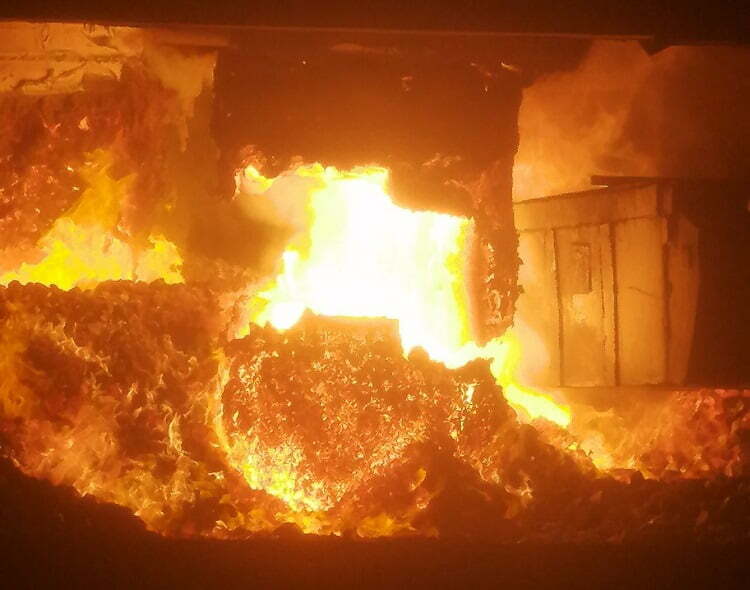Ferroalloys smelting methods mainly include the electrothermal reduction method (submerged arc furnace ferrochrome production) electrothermal reduction method (submerged arc furnace for ferrochrome production), metal thermal reduction method, and electrolysis method.
Ferroalloys adopt different smelting methods according to product varieties and quality requirements, mainly including the carbothermal reduction method (blast furnace method), electrothermal reduction method (submerged arc furnace for ferrochrome production), metal thermal reduction method, and electrolysis method. High-carbon and high-silicon ferroalloy products can also be refined by electro-silicon thermal reduction, oxygen-blowing decarburization, vacuum solid-state decarburization, and other processes, and converted into medium and low-carbon ferroalloy products.
blast furnace smelting
The main equipment is a blast furnace. The process of smelting ferroalloy in the blast furnace is basically the same as that of smelting pig iron in the blast furnace, which is called the carbothermic reduction method. The products include ferromanganese, mirror iron (ferromanganese containing less than 30% of manganese), low silicon ferrosilicon (containing 10% to 15% of silicon), and ferronickel.
Submerged Arc Furnace Smelting (Submerged Arc Furnace for Ferrochrome Production)
The vast majority of ferroalloy products, such as ferrosilicon, carbon ferromanganese, silicon manganese alloy, carbon ferrochrome, nickel-iron, silicon chromium alloy, silicon calcium alloy, etc., use submerged arc furnaces for ferrochrome production.
In the submerged arc furnace, the ore is mixed with coke or another carbonaceous reducing agent, and the smelting is carried out by electric heating.
When the submerged arc furnace is running, the electrodes are buried in the charge, and in addition to the arc heat generated between the end of the electrode and the furnace bottom or coke layer, the resistance heat generated by the current passing through the charge and the slag also plays a heating role.
Since elements such as manganese and chromium are easy to combine with carbon to form carbides, in the process of smelting ferromanganese and ferrochromium, ferroalloy products with high carbon content are generally obtained. In other products such as silicon-manganese alloy, silicon-chromium alloy, silicon-calcium alloy, etc., because of the effect of silicon, the carbon content in the product is generally low. Since electricity is the main source of heat and carbon is the main reducing agent in the smelting process of submerged arc furnaces, it is called the electrothermal method or electro-carbothermal method.
In general submerged arc furnace operations, the ferroalloy melt and slag flow out from the tap hole and the slag outlet at regular intervals. Iron alloys with a particularly high melting point (such as ferrotungsten), are produced by the iron extraction method or the agglomeration method.
A submerged arc furnace is the main equipment for the electrothermal smelting of ferroalloy. Because most of the electrodes of the submerged arc furnace are deeply buried in the charge, it is also called a submerged arc furnace. Submerged arc furnace parameters are one of the important factors that determine the technical and economic indicators of ferroalloy production and are divided into equipment parameters and smelting characteristic parameters.
In the smelting process of a submerged arc furnace ferrochrome production, the principle of using a carbonaceous reducing agent is:
①The amount of carbon distribution required to complete the ore reduction is called “chemical carbon distribution”.
② The process design to solve the influence of the reducing agent in the charge on the conductive behavior and permeability of the charge, that is, the resistivity of the reducing agent, the particle size, and the particle size ratio of the ore and the reducing agent, is called “physical carbon matching”.
Refining Process
The technology of re-smelting the crude ferroalloy is obtained by smelting in a submerged arc furnace or blast furnace.
The main processes are:
①
Converter Oxygen Method. The main equipment used in the oxygen converter method is a converter. According to its oxygen supply method, there are top, bottom, side-blowing, and top-bottom composite blowing methods. The raw materials used are liquid high-carbon iron alloy, pure oxygen, coolant, slag-forming materials, etc. The liquid high-carbon ferroalloy is mixed into the converter, and the high-pressure oxygen is passed through the oxygen lance into the furnace for blowing, and the heat released by the oxidation reaction is used for decarburization, and the production is carried out intermittently. The main varieties produced are medium and low-carbon ferrochromium, medium, and low-carbon ferromanganese, etc.
② submerged arc furnace ferrochrome production – shake the bag method. In a kind of electro-silicon thermal reduction refining process, the medium and low carbon silicon-manganese or silicon-chromium master alloy is obtained by smelting in a submerged arc furnace, manganese ore or chrome ore is used in refining electric furnace and shaker bag, and lime flux is added to carry out desilinization reaction.
③ Vacuum solid-state decarburization method. Grind the solid iron alloy with high carbon content into powder, mix with appropriate oxidant, carry out decarburization reaction under vacuum conditions after mixing, pressing, and drying, and obtain micro-carbon iron alloy products, which are mainly used for the preparation of carbon-containing iron alloys. Low carbon ferrochrome.
④ heat exchange method. The method of desiliconization and refining is by mixing liquid metal into liquid slag, the inventor is R. Perrin, so it is also called the Perrin method. Mainly used for the refining of ferrochromium.

